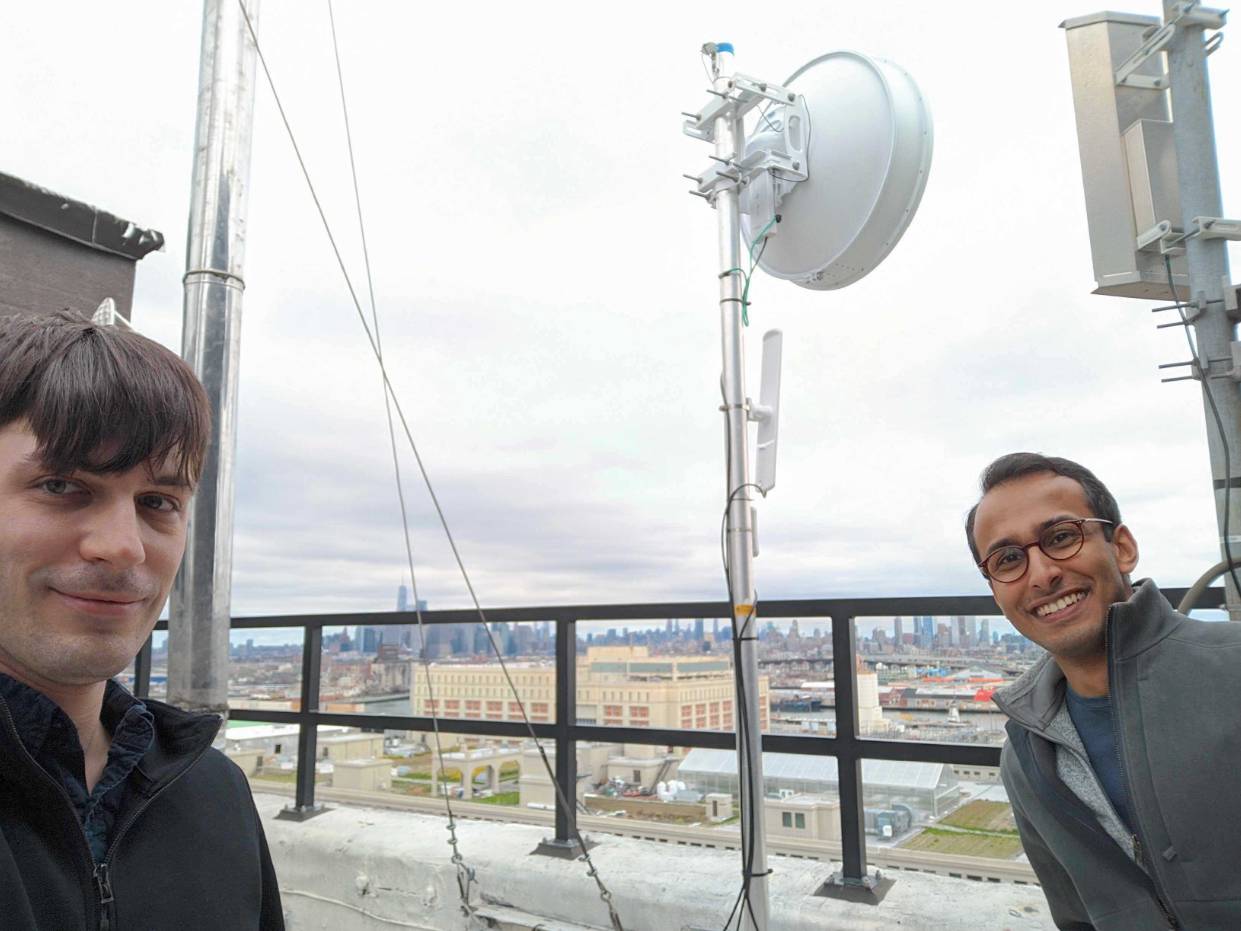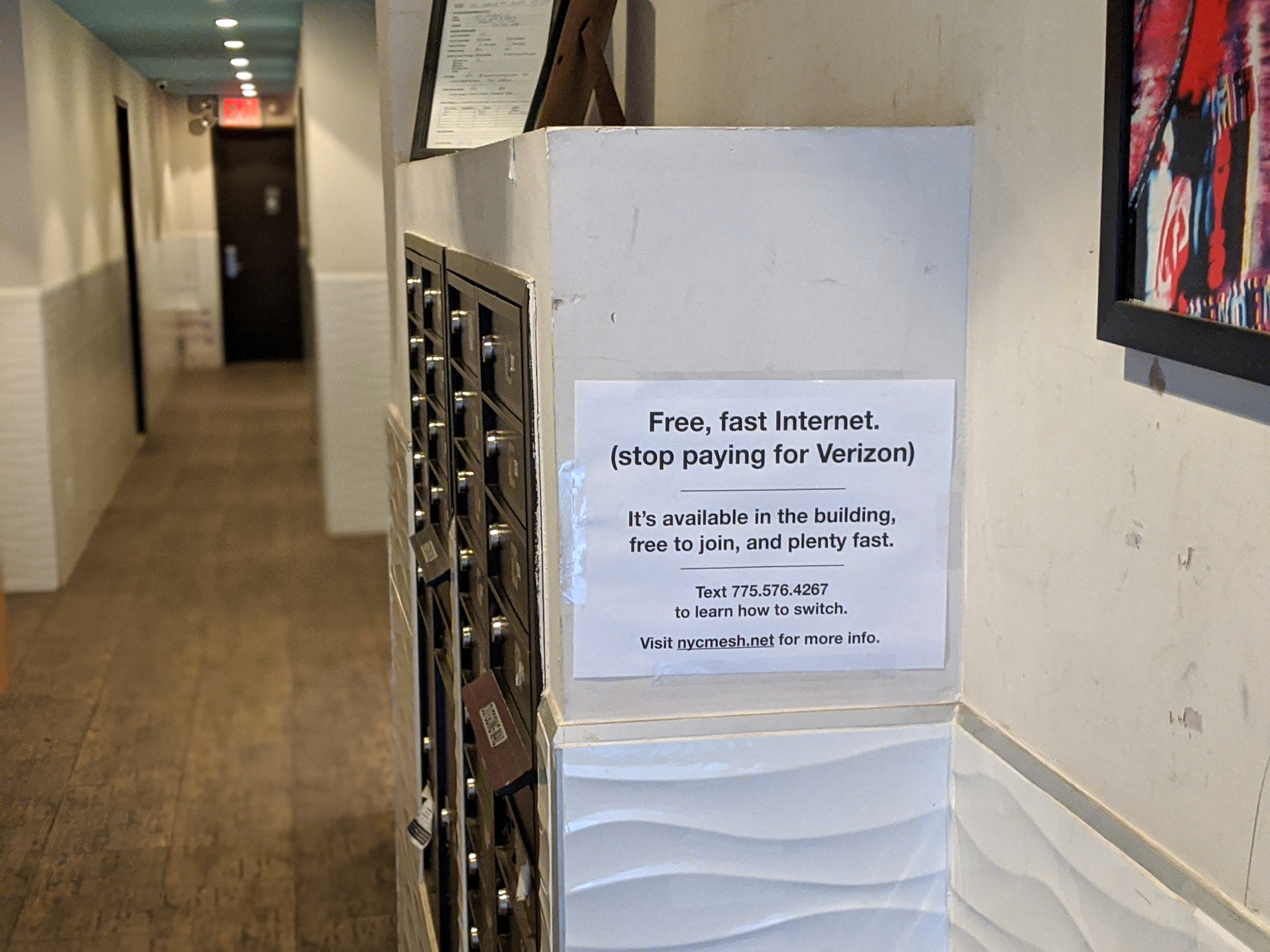
Willem
Supporting our Network During the COVID-19 Lockdown
The COVID-19 pandemic has upended the way we live, work and learn, and access to the internet has been critical to staying in touch with family, doing our jobs from home and continuing to attend school. At NYC Mesh our volunteers have been working hard to improve connectivity for our existing members, help new members set up their own DIY installs, run virtual training sessions and pursue new partnerships with allied organizations.
I talked to two of our most active volunteers, Zach and Rohan, about how they’ve been contributing to NYC Mesh during the crisis.

Zach (L) leads a socially-distanced upgrade to Supernode 3 with Aakash (R) during the lockdown
Zach Giles has been involved in Mesh for five years. He is our most experienced network engineer and also serves as a board member and spokesperson for the organization.
WB: What motivates you to be part of NYC Mesh and have those motivations changed since COVID-19?
ZG: We’ve been building a community network to connect the unconnected and since the lockdown the motivation remains the same. In areas that didn’t have internet before Coronavirus maybe it wasn’t critical to people’s lives but now we realize that it is critical because kids need to get online to stay in school, things like that.
WB: Since the lockdown began, what changes have you seen in how Mesh is used, and have those changes posed any challenges from your perspective as a network engineer?
ZG: We doubled the bandwidth utilization over the last couple of months, with a pretty noticeable upcurve when working from home started. For some people it became slower and so we’ve worked quite hard to increase bandwidth in those areas.
WB: Will responding to the increased demand help in the long run to make our network more resilient?
ZG: If we set it up to handle more traffic now, hopefully we’ll be able to sustain times like this again, or bigger evening bursts or 4k or whatever comes along next. There are also projects we were thinking of doing before the lockdown but didn’t get around to, like deploying additional supernodes, and you know, this crisis might jumpstart doing them. And then we might say, ‘Well that was easy! That was fun! Let’s keep it going.’
WB: Do you think there’s any silver lining to our current hold on volunteer-led installs?
ZG: Pausing has allowed us to do things like increase the bandwidth and reliability in certain areas, because we were growing pretty quickly before. So we’ve been able to take a step back and do some infrastructure changes. And while our volunteer install calendar has been paused, DIY installs keep happening.
WB: There’s been a lot in the news about commercial internet service providers coming out with special offers during the lockdown, but how is the fact that we’re a community organization helpful to our membership during this crisis?
ZG: Most of the commercial installations have also paused! The challenge is that you can’t install it yourself. You might be able to if the equipment’s already there, but it’s very unlikely that you could actually do it. A lot of our installations during Coronavirus have been DIYs, and the people who have done them have asked a lot of questions and actually learned about the technology and then they did it and they were proud of it. That’s a positive compared to a for-profit company where you’re not allowed to touch the infrastructure.

Rohan poses with his DIY hub gear
Rohan Singh is one of our newest members. Since setting up his own rooftop hub, he’s helped other new members set up their own DIY installs and has worked hard to improve connectivity for people in his building and in his neighborhood in Brooklyn.
WB: How long have you been involved in NYC Mesh?
RS: Not very long, less than two months! I’d been aware of Mesh for a couple years, and finally I had some issues with Verizon and that pushed me over the edge.
WB: What kind of setup did you install at your building?
RS: Just a couple Litebeams and an Omnitik. I started sharing my connection with my neighbors using my old home router but it got overloaded from people using it and it was crashing so I actually got a Ubiquiti long-range router and set up Mesh Wifi on that, and so there’s a lot of people who are now able to connect to it.
WB: They’re accessing the internet through the NYC Mesh guest network?
RS: Yeah, exactly. And actually the reason I think people noticed it is that our building’s roof is easily accessible. And I think with everything going on right now that’s the way people are able to get outside, and when they’re up there they notice the equipment and notice there’s free WiFi. Obviously I think Coronavirus has led people to notice stuff more. I also put a sign in the hallway just by the entrance to the building. I just typed something up and printed it out.

Rohan’s sign
WB: And people reached out to you directly?
RS: Yeah, actually somebody called last week to try and get connected. And that’s my neighbor, who’s now waiting for her own dedicated router to arrive in the mail. I think she just saw the flyer I posted because she texted me and she said that she had already visited the website and set up a recurring donation!
WB: How did you decide to share your connection with your neighbors?
RS: I read the network commons license and it just seemed like if I’m connected to the network than I should do the best I can to share it! My background is in software engineering and I do a lot of work with open-source software so it’s kind of the same ethos. You have access to this resource and you should share it with other people.
WB: I also noticed that you’ve been doing quite a bit of support work on Slack.
RS: I was just hanging out on Slack, and I noticed that Olivier, who had helped me with a lot of stuff, was having to deal with all these issues in the support channel, and I thought I could do a little more and try to respond to some of these issues. There was a neighbor a 10 minute walk from me whose antenna had become misaligned in the wind, so, I just said, ‘Ok, let me just walk over there and realign it for you.’ And so for that kind of thing, I feel like whenever I can I’m happy to help out. And it’s also nice to see so many people doing DIY installs right now. I spent a couple of weeks trying to figure out the right equipment, so if I can make it easier for other people I’m happy to do that!
WB: How do you think our DIY spirit helps in a time like this?
RS: You can’t get Verizon hooked up right now. I don’t know about Optimum, but I’ve talked to people online and it seems like it just isn’t possible right now. Because there aren’t enough people to do the work and it isn’t necessarily safe and they don’t have self-install options. Whereas with Mesh, it can be a little more complicated to do it yourself, but at least you have the option!
WB: Has there been one particular moment of pride from your experience so far?
RS: The windstorm that happened a couple weeks ago dislodged the Airfiber antenna at the Prospect Heights hub so I went over there, and Zach and Akash went to Supernode 3 to beef up the antenna on that side, and after that group effort the capacity of the Prospect Heights hub doubled. It was great to see people being able to do things they hadn’t been able to do before, like sync all their dropbox stuff from work. We finally had the capacity to handle that kind of traffic.
WB: What else are you doing to stay well right now?
RS: I think it’s a lot the same as other people, mostly staying inside, doing video calls. My partner and I have come up with this ritual where around 5:30 every weekday when we’re done with work we go up to the roof of our apartment building and just hang out there and have a beer. And it’s nice to be outside for a little while. That’s pretty much it! Otherwise, just trying to stay focused, stay sane, you know?